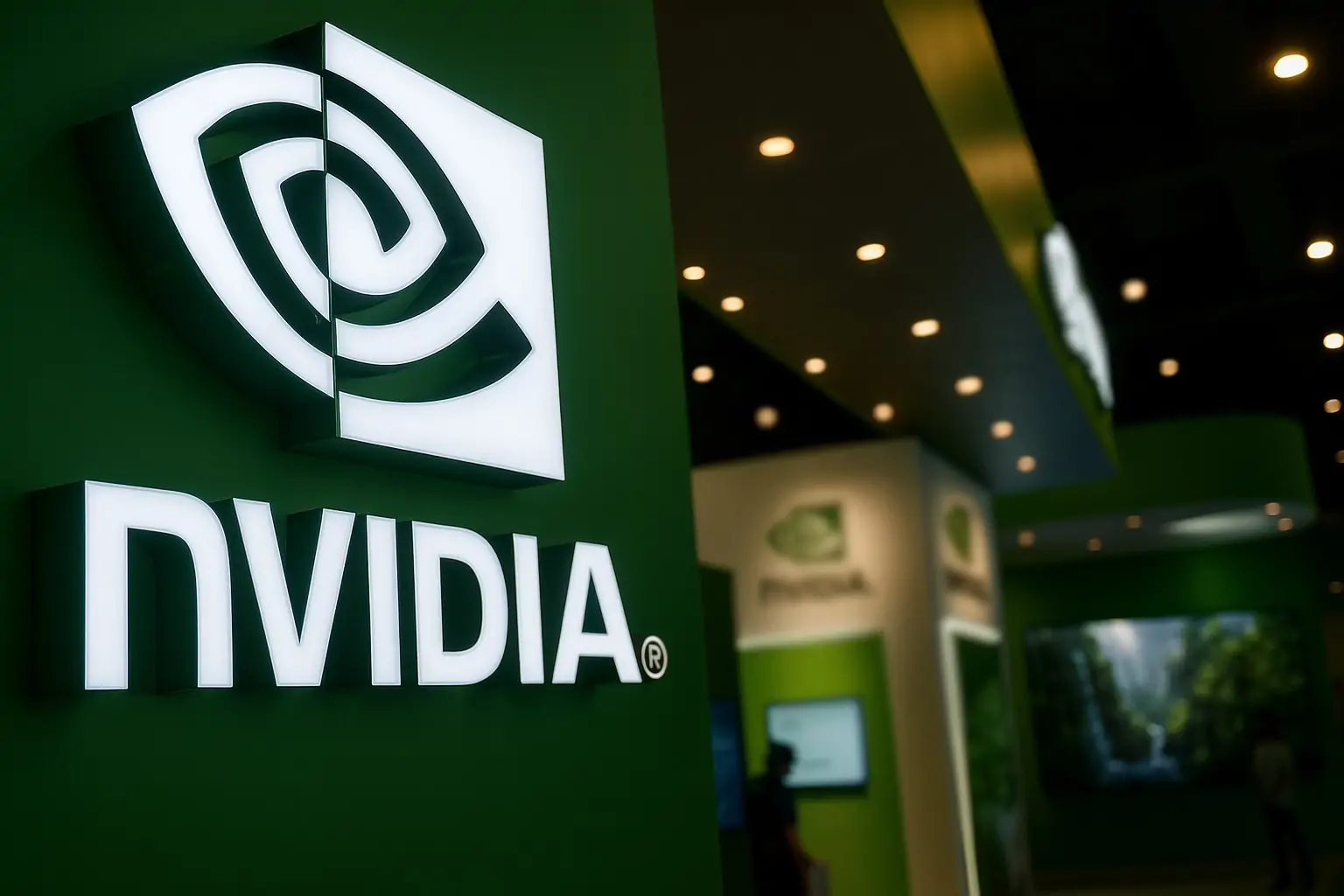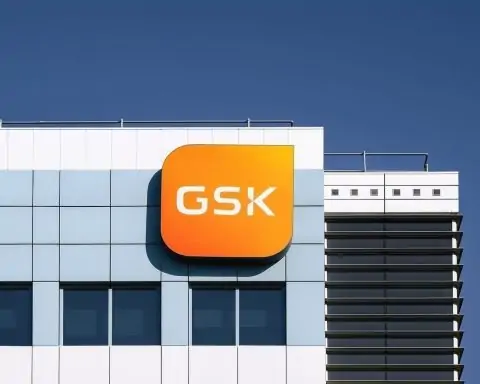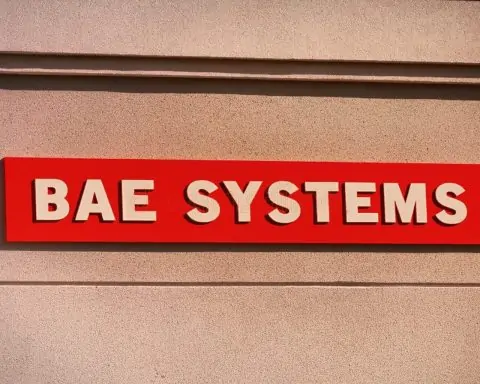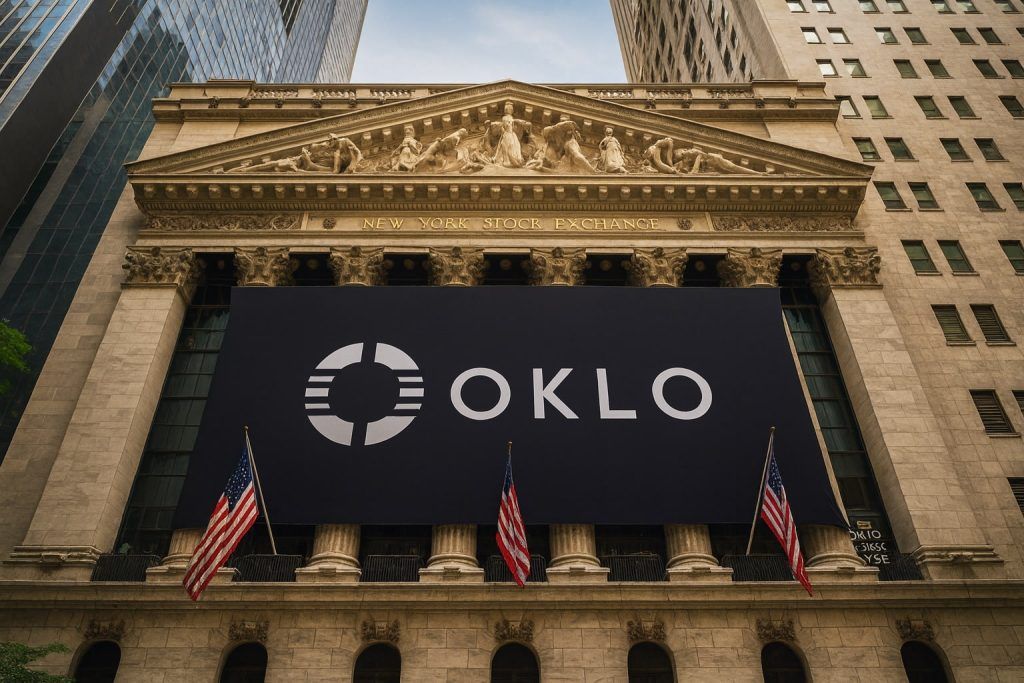Nvidia Corporation (NASDAQ: NVDA) heads into one of the most closely watched earnings days in market history today, 19 November 2025. Options markets are pricing in a potential post-earnings move of about 7% in either direction — a swing that could add or erase roughly $320 billion in Nvidia’s market value, the largest earnings-day value change ever for a single company. [1]
At the same time, global stocks have wobbled as investors fret about whether the artificial intelligence boom has run ahead of fundamentals. Nvidia’s third-quarter fiscal 2026 results, due after the U.S. market close, have effectively become a referendum on the AI trade itself. [2]
Today’s Top Nvidia (NVDA) Headlines – 19 November 2025
Here are the most important Nvidia-related developments today:
- Earnings day & AI referendum:
Global markets have stabilised after a sharp tech selloff, but sentiment is fragile as traders wait for Nvidia’s results, which many see as “make-or-break” for AI valuations. [3] - Wall Street expects another explosive quarter:
Consensus forecasts call for Nvidia’s Q3 FY26 revenue to jump roughly 56% year-on-year to the mid‑$50 billion range (around $54.9–$56.9 billion), keeping growth elevated on top of already massive sales. [4] - Options imply record volatility:
A Reuters analysis finds options are pricing a roughly 7% one‑day move after earnings, implying a potential $320 billion swing in market value — larger than Nvidia’s own record post-earnings jump in early 2024. [5] - Market jitters over an AI “bubble or breakout”:
Nvidia shares are up around 1,200% over the past three years but have dropped nearly 8% so far in November as some high-profile investors, including funds tied to Peter Thiel and Masayoshi Son, have trimmed positions. [6] - $24B AI “deal blitz” under scrutiny:
New analysis shows Nvidia has invested about $23.7 billion across 59 AI-related deals this year, often in its own customers — raising questions about “murky” circular investments and revenue visibility. [7] - New Menlo Micro partnership speeds up AI chip testing:
Nvidia and startup Menlo Micro say new MEMS-based switching chips can accelerate testing of Nvidia’s GPUs by 30–90%, easing a critical production bottleneck as demand for AI accelerators soars. [8] - US approves export of advanced Nvidia chips to Armenia:
The U.S. government has cleared AI startup Firebird to export Nvidia’s advanced processors to Armenia for a $500 million, 100‑megawatt AI supercomputing facility using Nvidia’s next-generation Blackwell chips and Dell servers, with first-phase operations expected in Q2 2026. [9] - Memory market shock brewing:
A Counterpoint Research report warns Nvidia’s planned shift from DDR5 to smartphone-style LPDDR memory in its AI servers could double server-memory prices by late 2026, intensifying supply strains for cloud and AI providers. [10] - Global AI infrastructure push:
Brookfield Asset Management has launched a $100 billion AI infrastructure program in partnership with Nvidia and the Kuwait Investment Authority, anchored by a new AI infrastructure fund targeting $10 billion in equity commitments. [11]
NVDA Stock Today: How the Market Is Trading
As of early afternoon on 19 November, Nvidia shares trade around $186.46, up roughly 2.8% on the day, outperforming broader tech indices as investors position ahead of earnings. [12]
Despite the bounce, Nvidia is still off its late‑October high amid a broader pullback in richly valued AI names. Globally, equities have seen their longest streak of losses since August, with the Nasdaq more than 6% below recent records on worries that AI valuations are “priced for perfection.” [13]
What Wall Street Expects from Nvidia’s Q3 FY26 Earnings
Revenue and EPS
Analysts surveyed by LSEG and other data providers expect Nvidia to report:
- Revenue: roughly $55–57 billion, up about 56% year-on-year for the quarter ending late October. [14]
- Earnings per share (EPS): estimates cluster around the low‑$1.20s to mid‑$1.20s per share, based on recent analyst round‑ups and earnings previews. [15]
For context, Nvidia generated $46.7 billion in revenue in the prior quarter (Q2 FY26), up about 56% vs. a year earlier, with net income of $26.4 billion and a net margin above 50%. [16]
In other words, Wall Street is asking Nvidia not just to grow fast, but to accelerate on top of a revenue base already north of $45 billion per quarter.
Growth Engines: Data Centers and AI GPUs
Today’s report will focus heavily on:
- Data center revenue: Still the core of Nvidia’s AI story, powered by H‑class and Blackwell accelerators deployed in hyperscale cloud data centers. Analysts are watching whether data-center growth outpaces total revenue again — any sign of “digestion” by major cloud customers could rattle the stock. TechStock²+1
- Margins: Reuters notes that complex production ramp‑ups for next-gen AI systems and constraints in the supply chain have begun to squeeze margins at the edges. Investors will parse gross margin and operating expense trends for signs that pricing power is slipping or costs are rising too fast. [17]
- Bookings and backlog: CEO Jensen Huang recently talked about roughly $500 billion in bookings for advanced chips through 2026 — any update could become the headline number for long‑term AI demand visibility. [18]
AI “Bubble or Breakout”? Why This Earnings Day Matters So Much
Three years after generative AI burst into the mainstream, Nvidia has become the anchor of the entire AI trade:
- It dominates the market for GPUs used to train large language models and other AI workloads. [19]
- It carries roughly 8% weight in the S&P 500, giving its earnings outsized influence on major indices. [20]
- Its stock has surged about 1,200% in three years, but dropped nearly 8% this month as bubble concerns spread. [21]
Reuters describes tonight’s report as a key test of whether AI is in “bubble or breakout” territory. The fear is that:
- Circular AI deals — where big tech firms, cloud providers and startups invest in one another while also buying services and chips — may be inflating revenues in ways that are hard to sustain. [22]
- Several prominent investors, including Peter Thiel’s hedge fund and SoftBank CEO Masayoshi Son, have taken profits on Nvidia and other AI names, adding to the sense that sentiment is shifting from euphoria to caution. [23]
On the other hand, demand for Nvidia’s GPUs remains intense, with hyperscalers such as Microsoft continuing to pour billions into AI data centers. Even many skeptics accept that AI spending will stay structurally high; the open question is whether current expectations have simply become too high for any single quarter to satisfy. [24]
Nvidia’s $24B AI Investment Blitz: Growth Engine or Red Flag?
One of the biggest talking points today is a new analysis of Nvidia’s aggressive deal-making.
According to Yahoo Finance, Nvidia has invested about $23.7 billion across 59 AI-related deals since the start of 2025. Many of these deals involve startups and platforms that are also Nvidia customers, creating what some on Wall Street are calling a “$24 billion AI deal blitz.” [25]
Key concerns raised by analysts and investors include:
- Circularity: When Nvidia invests in an AI company that then uses a large share of that funding to buy Nvidia GPUs, it can blur the line between organic demand and demand effectively financed by Nvidia itself. [26]
- Transparency: While strategic investments are common in tech, the sheer scale of Nvidia’s commitments is prompting calls for clearer disclosure on how much AI revenue is tied to such partner deals. [27]
- Balance sheet and capital allocation: With Nvidia already spending heavily on capex, R&D, and buybacks, some observers worry that funneling tens of billions into equity stakes could reduce financial flexibility if AI spending normalises. [28]
Supporters argue that these stakes deepen Nvidia’s position at the heart of the AI ecosystem, giving it early access to promising models, software platforms and data-center operators. The market will be watching tonight’s call for any hints on how management thinks about returns on this growing investment portfolio.
New Partnership: Menlo Micro and the Race to Test AI Chips Faster
Demand for Nvidia’s GPUs is so intense that even testing them has become a bottleneck.
A new Reuters report today details how Nvidia and California-based startup Menlo Micro have developed specialized switching chips — built using micro-electromechanical systems (MEMS) — that dramatically speed up the testing process for Nvidia’s high-power AI GPUs. [29]
Highlights from the collaboration:
- Menlo Micro’s switching chips replace older components on test boards that were never designed for today’s ultra‑fast, power-hungry AI accelerators. [30]
- In a joint research paper, engineers from the two companies report that these improvements can accelerate chip testing by 30–90%, depending on the test type. [31]
- Menlo Micro, spun out of GE in 2016 and backed by investors including Corning and Tony Fadell’s venture fund, says other major chipmakers are also adopting its switching technology. [32]
For Nvidia, the partnership is critical: if chips can’t be validated quickly, they can’t be shipped, no matter how strong demand is. Faster testing helps Nvidia better match supply to the enormous AI appetite of its data-center customers.
Export Controls and Geopolitics: US Approves Nvidia Chips for Armenia AI Supercomputer
Today also brought a notable development on the geopolitical front.
OC Media, citing Bloomberg, reports that the U.S. government has approved AI startup Firebird’s export of advanced Nvidia processors to Armenia for a $500 million artificial intelligence supercomputing facility. [33]
Key details:
- The project, announced by Nvidia in June, will be the first large-scale AI data center in the South Caucasus, with planned power capacity of 100 megawatts. [34]
- The facility will use Nvidia’s next-generation Blackwell chips and AI servers from Dell Technologies, with the first phase expected online in Q2 2026. [35]
- Around 20% of compute will be reserved for domestic Armenian companies, while 80% will serve U.S.-based firms operating in the region, highlighting how AI infrastructure is becoming a geopolitical asset. [36]
- The approval comes after changes to U.S. export rules: Armenia had been treated as a “second-tier” country under an AI diffusion rule, but those restrictions have since been lifted by the current administration. [37]
The Firebird project underscores how Nvidia’s chips sit at the intersection of technology, foreign policy, and regional development. Export approvals — or denials — can materially shape where AI capacity is built and who gets access to it.
Memory Market Shock: Nvidia’s Shift to Smartphone-Style LPDDR
Beyond GPUs, Nvidia’s design choices are now reshaping other semiconductor markets.
A Counterpoint Research report, cited by Reuters, says Nvidia plans to move its AI servers away from traditional DDR5 memory toward LPDDR, the low-power memory commonly used in smartphones. Because AI servers require vastly more memory than phones, this shift could double server-memory prices by late 2026 if supply fails to keep up. [38]
That would have several implications:
- Higher infrastructure costs for cloud providers and AI startups already facing steep GPU, power and data-center bills.
- Further strain on memory suppliers, which had previously prioritised high-bandwidth memory (HBM) for AI chips and may now face shortages in multiple segments. [39]
- Even tighter linkages between Nvidia’s product roadmap and the broader semiconductor supply chain, amplifying the company’s influence far beyond GPUs.
Massive AI Infrastructure Buildout: Brookfield–Nvidia Deal
Finally, on the infrastructure side, Brookfield Asset Management today announced a $100 billion AI infrastructure program in partnership with Nvidia and the Kuwait Investment Authority. [40]
- The initiative is anchored by a new Brookfield Artificial Intelligence Infrastructure Fund targeting $10 billion in equity commitments. [41]
- The capital will be used to build and operate AI-ready data centers and related energy infrastructure around the world, with Nvidia positioned as a core technology partner. [42]
This reinforces a key theme of Nvidia’s story: AI is no longer just about chips; it’s about entire ecosystems of compute, power, and connectivity, and Nvidia is working to embed itself at every layer.
What to Watch on Tonight’s Earnings Call
Heading into the Q3 FY26 report, here are the five big questions investors and analysts will be listening for:
- Is AI demand still accelerating, or just steady?
- Any slowdown in data-center growth or bookings could feed “AI bubble” narratives.
- How healthy are margins?
- Higher costs from advanced packaging, complex systems, and supply constraints could pressure profitability.
- How dependent is growth on Nvidia-funded customers?
- More detail on the $24B investment portfolio would help investors gauge how much AI demand is truly organic.
- What’s the outlook on export controls and new markets?
- Updates on China restrictions, approvals like the Armenia project, and potential deals in regions such as the Middle East will be closely watched.
- How does Nvidia see the broader AI cycle?
- Management’s commentary on whether we’re early, mid, or late in the current AI investment wave could shape sentiment across the entire sector.
Important note: This article is for information and news purposes only and does not constitute financial or investment advice. Always do your own research and consider speaking with a licensed financial adviser before making investment decisions.
References
1. www.reuters.com, 2. www.reuters.com, 3. www.reuters.com, 4. www.reuters.com, 5. www.reuters.com, 6. www.reuters.com, 7. finance.yahoo.com, 8. www.reuters.com, 9. oc-media.org, 10. www.reuters.com, 11. m.economictimes.com, 12. www.wsj.com, 13. www.reuters.com, 14. www.reuters.com, 15. meyka.com, 16. www.google.com, 17. www.reuters.com, 18. www.reuters.com, 19. www.reuters.com, 20. www.reuters.com, 21. www.reuters.com, 22. www.reuters.com, 23. www.reuters.com, 24. www.reuters.com, 25. finance.yahoo.com, 26. finance.yahoo.com, 27. finance.yahoo.com, 28. finance.yahoo.com, 29. www.reuters.com, 30. www.reuters.com, 31. www.reuters.com, 32. www.reuters.com, 33. oc-media.org, 34. oc-media.org, 35. oc-media.org, 36. oc-media.org, 37. oc-media.org, 38. www.reuters.com, 39. www.reuters.com, 40. m.economictimes.com, 41. m.economictimes.com, 42. m.economictimes.com







